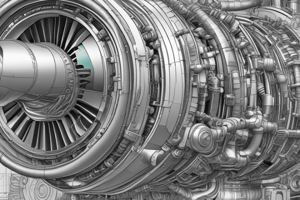Podcast
Questions and Answers
What is the purpose of obtaining start clearance from fireguard or observer?
What is the purpose of obtaining start clearance from fireguard or observer?
- To ensure the aircraft is ready for takeoff
- To comply with RPM limits
- To ensure safety by avoiding jet efflux danger zones (correct)
- To prevent structural damage to the aircraft and engine mounting
Which of the following is NOT included as a limit to observe when carrying out engine runs?
Which of the following is NOT included as a limit to observe when carrying out engine runs?
- Oil temperature limits
- Fuel consumption rate (correct)
- Wind direction and strength
- RPM or torque limits
What is the significance of observing turbine gas temperature limits during engine runs?
What is the significance of observing turbine gas temperature limits during engine runs?
- To prevent engine hot soak limits
- To avoid exceeding structural damage limits (correct)
- To maintain minimum and maximum torque pressure limits
- To prevent blast deflectors from malfunctioning
Why is it important to have the power lead removed after starting the engine with external power?
Why is it important to have the power lead removed after starting the engine with external power?
What aspect of engine performance assessment requires particular emphasis during engine runs?
What aspect of engine performance assessment requires particular emphasis during engine runs?
Which of the following is a potential danger area during engine runs?
Which of the following is a potential danger area during engine runs?
What is the purpose of emergency procedures in aviation?
What is the purpose of emergency procedures in aviation?
Why is it important to read instruments accurately in aviation?
Why is it important to read instruments accurately in aviation?
What should operators do when encountering an emergency situation?
What should operators do when encountering an emergency situation?
Which of the following is NOT listed as a potential emergency situation that could be encountered?
Which of the following is NOT listed as a potential emergency situation that could be encountered?
Why is it crucial to detect unsafe situations promptly during an engine run?
Why is it crucial to detect unsafe situations promptly during an engine run?
What is one potential consequence of inaccurate instrument reading during an engine run?
What is one potential consequence of inaccurate instrument reading during an engine run?
Study Notes
Quick Reaction and Crew Co-operation
- Quick reaction times and crew co-operation are essential to prevent or minimize aircraft damage and/or crew injury in all emergency situations.
Engine Fire Checklist
- A turbopropeller engine fire checklist includes:
- Fire warning
- Throttle retard to shut-off
- Propeller condition lever select feather
- Fire handle selected (pulled)
- Fire bottle button select first shot
- Radio call to airfield tower for fire-crew assistance
- Other engine(s) shut down
- Fire bottle button select second shot if fire warning light is not out
- Batteries/ground power off
- Vacate aircraft and ensure all non-essential crew vacate the aircraft and proceed to the designated assembly point
- Head count completed
Feathering Propellers
- Propellers are feathered to prevent personnel from walking into a propeller that is still running down.
- Feathering a propeller drives the blades into a coarse pitch position, which aids in rapid engine shut down.
- Feathering a propeller also ensures that the engine's shut-off valve isolates fluid movement to and from the engine.
Engine Start Procedure
- Obtain start clearance from fireguard or observer.
- Carry out start procedure, taking care to remain within:
- Turbine gas temperature limits
- RPM limits
- Oil pressure limits
- Starter duration and engagement limits
- Carry out relevant post-start checks once the engine has started and stabilized at idle.
- Have power lead removed if external power was used to start the engine(s).
Engine Limits
- Engine limits to observe include:
- RPM or torque limits during ground runs to prevent structural damage to aircraft and engine mounting
- Turbine gas temperature limits
- Oil temperature and pressure limits
- Engine hot soak limits prior to recording engine parameters
- Engine load restrictions when recording engine parameters
- Wind direction and strength
Instrument Reading
- Engine parameters are observed by operators during engine runs or during flight.
- Particular emphasis is placed on reading instruments accurately when assessing engine performance.
- Instrument reading errors can occur due to parallax error.
- Incorrect engine adjustments or component rejection could result from inaccurate instrument reading.
Emergency Procedures
- Emergency procedures are carried out upon detection of an unsafe situation that could damage an engine or aircraft component, or endanger personnel.
- Emergency situations require immediate action and follow relevant corrective actions and/or shut-down procedures.
- Examples of emergency situations include:
- Engine fire
- Engine overheat
- Turbine overheat
- Aircraft fire
- Leading edge overheat
- Engine runaway
- Engine seizure
- Oil pressure out of limits
- Oil loss
- Engine fuel leak
- Wheel well hydraulic leak.
Studying That Suits You
Use AI to generate personalized quizzes and flashcards to suit your learning preferences.
Description
Test your knowledge on the importance of accurate instrument reading, the impact of parallax error, and how to avoid incorrect engine adjustments or component rejection. The quiz is based on Figure 8 from the DEFENCE AEROSKILLS TRAINING ACADEMY materials.




